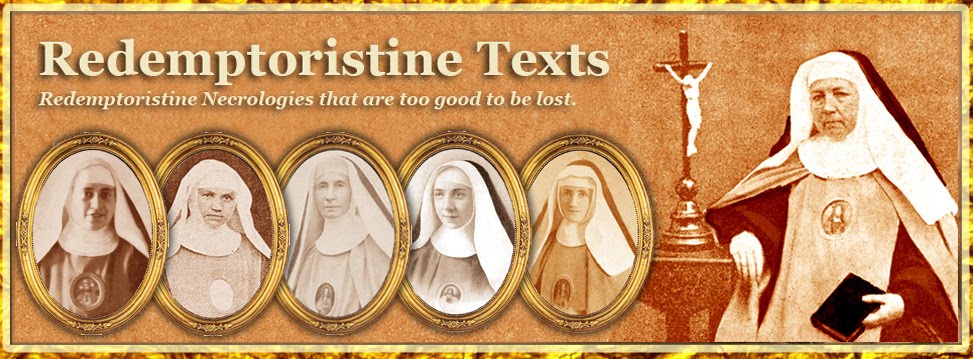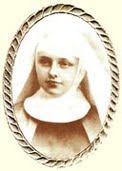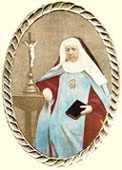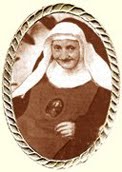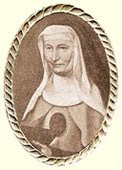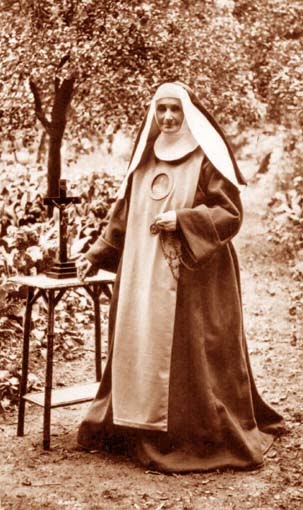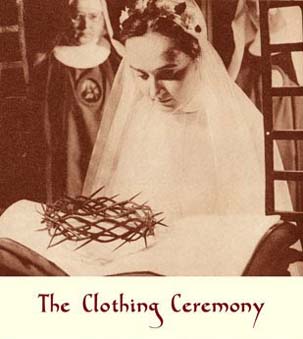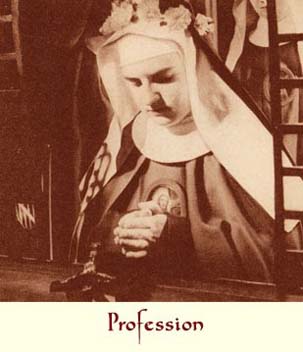Chapter I. Roubain, Esquermes, Malines.
I. In the boarding school.
The revered Mother Marie-Joseph of the Child Jesus, in the world Miss Marie Wattinne, was born at Roubaix (France) in one of the most honourable families of that town. Her worthy parents, Mr. and Mrs. Wattinne-Prouvost, in spite of the most striking contrasts of nature, demonstrated in themselves the archetype of Christian spouses.
Mr. Fidèle Wattine, of pure Tourcoing descent, preserved a proverbial good humour under the ice of his old age, and very skillful did he need to be to extricate himself from the pleasant stunts he dreamed up. Later on, the account of his bizarre schemes enlivened more than once the monastic recreations of the pious daughters of the Reverend Mother.
Mrs. Wattinne, a woman of duty par excellence, personified in herself the imperturbable calm of her family lineage. When she was a young lady, she was called the good Therese Prouvost. The revered Mother has said more than once that she could never recall having ever seen her laugh, but she well remembered the tears that she saw her shed one day when her little Marie committed one of those trifling indiscretions usual at a young age.
Nonetheless, the most virile faith united these two hearts by bonds that soon the joys of maternity rendered more sacred and more sweet.
Miss Marie was the sixth or the seventh of their thirteen children, six of which died at an early age. She came into the world on 22nd March 1836 and was baptised the following day in the church of Saint Martin. It was also under the auspices of the Thaumaturge of the Gauls [St. Martin of Tours] that she later made her first communion and received Confirmation. She was held over the baptismal font by her great-great-uncle, Mr. Jacques Desmazières, and by her first cousin, Mrs. Jules Desurmont-Wattinne. She was called Marie Laurente Joseph, names which were always dear to her tender piety.
In the example of her divine Mother and Patron, little Marie was devoted to God from the moment she learnt to know Him, and prayer was the habitual recourse of her soul. Under a timid exterior, the effect of her reserve and angelic modesty, flashes were revealed in her private friendships of a lively, outgoing and always lovable nature. A charming simplicity detracted nothing from the niceties of her little pranks. She was readily given the name of miss busy-body, as her natural activity led her to spread animation and life all around her.
The precocity of her judgement made her appreciated by the venerable Dean of Saint Martin, Father Maës. One day when he had gone to pay a visit to Mr. Wattinne, he was told that one of the little girls was ill. “Which one?” he asked. They told him that it was Josephine. “If it had been Marie,” Father Maës replied, “I would have confessed her.” Yet the child was then but scarcely seven years old.
Marie was enrolled successively as a day scholar at the boarding school run by the sisters Guffroy, and then that of the Ridder ladies, and merited to be seen by them as a model of good behaviour. On 6th April 1847, she had the sorrow of losing her excellent mother, whose virtues and examples had sown in the souls of her children the seeds of the most solid piety. Mrs. Wattine, a true type of the strong woman, left behind her the reputation of a saint. The following story will prove the strength of her faith. Fidèle, one of her sons, had a chest complaint and had been given up by the doctor. The following day, when he called again, he found the boy out of danger. “But Madam, what have you done?” the doctor asked. “Sir,” replied the Mother, “I prayed.” The boy recovered and survived until 28th October 1870.
Justine, the oldest in the family, a worthy scion of her virtuous mother, was thereafter in charge of the government of the house. She demonstrated a remarkable ability for it and pushed her devotion to the point of refusing the most suitable young men, until the day when, feeling herself less necessary to the family, she became in her turn a model spouse and mother.
However, the young Marie joyously saw the long-desired day of her first communion approaching. On 3rd June 1847, the day when the Church that year was celebrating the feast of the Blessed Sacrament, the angelic child, now aged eleven, and in the second month of mourning for her mother, received her God for the first time. Some days afterwards, the sacrament of Confirmation was administered to her by Mons. Giraud, the Archbishop of Cambrai. It was doubtless in these memorable days that she heard the first call of the Spouse of virgins in the depths of her heart. A soul so docile and so good was completely prepared for God’s plans.
In addition, she soon saw one of her sisters consecrate herself entirely to God. Two years after the death of Mrs. Wattinne, Sophie, her youngest, obtained permission from her generous father to become a Daughter of Charity. During the last twenty eight years of her religious life she was almost always in charge and died as the Superior of the Orphanage of Providence at Toulon on 6th December 1877, in the fifty first year of her age and the twenty eighth or her religious vocation.
In April 1849, the same year as the departure of her sister Sophie, Marie, now aged thirteen, was sent as a boarder to the Monastery of Our Lady of the Plain, directed by the Bernardine Nuns of Esquermes. Her tender piety, her exactitude and her spirit of piety soon classed her among the most pious Children of Mary in the boarding school. There as everywhere, her sweetness and good behaviour gained hearts for her and merited for her the nickname of little saint which has remained attached to her memory. After four years spent in this blessed house, she had to leave these fervent religious whom she had so greatly edified and whose happy vocation she envied.
II. At the paternal home.
When she came back to the paternal home in the month of August 1853, she gave clear evidence of the fruits of the solid and lovely virtues she had just gathered so abundantly from the vine of the Lord. All her family made it their duty to admire her examples, their law to follow her advice, their need to open their hearts to her, and their happiness to love her.
The following story will prove the greatness of her spirit of conciliation. One of her brothers, who loved her greatly, nonetheless, told her one day: “Marie, I would not like to have you for my wife, because you say ‘yes’ to everything, and I need someone who knows how to rein me in.” The future was to give a response to that remark, and justified sweet Marie by making her a mother as strong as she was tender when duty required it.
Miss Justine married on 29th May 1854 and left the family where for seven years she had taken the place of her mother. Marie, then aged eighteen, replaced her in the government of the house, yet she limited herself in the direction of the household and refused the supervision of the shopping, as she did not wish to make herself indispensable. Besides, her modesty was so great that she made one involuntarily think of her as a religious in the world. And yet she knew how to enjoy the relaxations permitted. On one occasion, the only one perhaps, she had to attend an evening of dancing which was given by her family. She astonished everybody by her joyful spirit, and when later on someone reproached her, she replied: “I assure you that everything happened with the most perfect propriety, and thank heavens, I did not lose my awareness of the presence of God for an instant.”
At the age of nineteen, Marie asked her father, for whom she was his joy and consolation, for permission to leave him in order to embrace the religious life. This request saddened, without surprising, this generous Christian whose faith had never been able to refuse anything to his God. So he authorised his daughter to present herself to the Redemptoristines of Bruges. This was in April 1855.
Thirteen years had scarcely passed since the opening of the first sheep-fold of the Most Holy Redeemer in Belgium, and already the happy flock who had placed themselves under the staff of the revered foundress, Mother Marie-Alphonse, had greatly exceeded the number fixed by the holy Rule.
Mons. Malou, the Bishop of Bruges, judged that the moment had come to establish a new monastery. After discussing it with the Superior, he profited from a meeting with the Belgian Bishops at Malines to ask them to accept this foundation. The suffragan Bishops found difficulties, but Cardinal Sterckx, the Archbishop of Malines, declared that he would be happy to see a house of the Daughters of Saint Alphonsus in Brussels. Mons. Malou went to the Monastery of the Redemptoristines in his episcopal city on 2nd April to himself choose the Sisters destined for the future foundation, and these left Bruges on Monday 16th, and on Wednesday 18th they arrived at the provisional house rented in Josaphat Street, in the suburb of Schaerbeek, Brussels, by Mother Marie-Alphonse.
It was there that our young Marie presented herself on 9th July 1855 to request her admission. Then she went straight back to Roubaix. When she returned to Brussels on 26th November, she stayed at the Monastery for about six weeks as had been arranged with her father. During this time she was so sad and so disappointed that the never ceased weeping. Mother Marie-Alphonse asked her why she was so afflicted. She replied: “I am weeping because everything here displeases me, and yet God wants me to remain here.” Nonetheless the religious, at her departure, asked her if they would see her again. When she went back to Roubaix, she did not say a word to her father about what she had suffered interiorly, but when the time agreed upon had elapsed, she went back courageously to her sheep-fold on 13th May 1856. She was then only twenty years of age.
III. The Novitiate. – Her religious profession. Her first trials.
As in all foundations, the beginnings were hard, and the deprivation of spiritual help was the greatest trial. However, nothing can describe this intimate union of hearts and minds whose memory is inseparable from this poor house in Brussels, where everything was lacking except fervour, good spirits and generosity.
Marie, resolved to belong to God no matter what it would cost, was also sustained by the advice of Mother Marie-Alphonse and the examples of the thirteen professed nuns. This pious community, satisfied with the young postulant, judged her worthy to have the three remaining months of her educandate cut short and admitted her to vesting. This ceremony took place on 19th February 1857. The new novice then received the name of Sister Marie-Joseph of the Child Jesus.
The year of her novitiate was spent in the fervent practice of the religious virtues. The 28th April 1858 was the wonderful day of her profession. This ceremony attracted from the other end of Lorraine the Redemptorist priest who had discerned, hatched and nourished this beautiful vocation. Rev. Father Assemaine [1] left his dear Convent of Saint Nicholas de Port for a moment and came to celebrate the grandeurs and duties of the religious life in a very apostolic discourse. There was a fine feast at the Monastery, and a great joy in the midst of the trials it was going through at this moment.
In fact, they had built the convent on a vast property overlooking the zoological garden in Brussels. Every bit of advice had been requested, and all the approvals granted, but, when the building had nearly reached completion, opinions changed and reproaches fell as thick as hail upon Mother Marie-Alphonse. Why had she chosen an estate so near to a public garden for her Monastery? Why had she given so grandiose an air to a refuge intended for poor religious? The good Mother recalled in vain that she had not chosen the site, and that on different occasions, she had recommended to the architect the most severe economy, but nothing sufficed. The good Mother saw only one refuge – prayer, and she threw herself into it. Throughout the whole Sunday that followed the feast of the Apostles Saint Peter and Paul, the Blessed Sacrament was solemnly exposed. While all the religious were at the feet of the Good Master, the Reverend Mother asked the divine Saviour exposed on the altar out loud to deign to save them in their distress. Her prayer was heard. Cardinal Sterckx suddenly felt, while he was celebrating the Holy Mass, irresistibly drawn to offer the Redemptoristines the Saint Louis Institute at Malines, which he could make available in the month of September. As if there was any need to say it, the Community accepted the offer with joyful gratitude.
“At this time,” says a contemporary, “the bills to pay rained down upon the community. Every ring of the bell brought fear into every heart. The good Mother did everything she could to satisfy the pitiless creditors as much as possible. But all the efforts of her heart, at once so upright and so generous, could not avert the catastrophe. Some time after the installation of the community at Malines, the lawsuit brought against her was won and the debts liquidated. The shareholders of the zoological garden of Brussels (Ixelles) became the owners of our magnificent property and the monastery, at a price below their real value.”
On 6th October 1858, on the feast of Saint Bruno, two special carriages left Josaphat Street, bringing, not into the land of captivity, but to the promised land, the religious victims of this long and harsh trial. Canon Van Campenhout, the Superior of the little seminary of Malines gave the community the most paternal welcome and promised them his most devoted assistance. This promise was kept, in both spiritual and temporal matters, with a benevolence that never decreased. The following day, Cardinal Sterckx came to pay the Sisters a visit. On 13th December he returned, accompanied by a numerous clergy, blessed the new Monastery and established the enclosure.
Sister Marie-Joseph of the Child Jesus spent seventeen years in the Monastery of Malines. There she held the most diverse functions. Equally apt to the government of souls and the management of temporal affairs, she fulfilled in turn the charges of Mother Vicar and Housekeeper, cared for the sick with the greatest devotion in her capacity as Infirmarian, and was named Mistress of Novices. In brief, her charity, discretion and good judgement had many occasions to be exercised, and her virtues gained her every heart. Also, when it was decided that a new foundation would be established in the Diocese of Cambrai, the community was unanimous in entrusting Sister Marie-Joseph with the direction of this enterprise. The very French heart of the good Sister thrilled at this news, and under the auspices of Our Lady of Grace, the patroness of the Diocese of Cambrai, who had smoothed out all the difficulties, she set off resolutely at the head of her little colony.
The revered Mother Marie-Joseph of the Child Jesus, in the world Miss Marie Wattinne, was born at Roubaix (France) in one of the most honourable families of that town. Her worthy parents, Mr. and Mrs. Wattinne-Prouvost, in spite of the most striking contrasts of nature, demonstrated in themselves the archetype of Christian spouses.
Mr. Fidèle Wattine, of pure Tourcoing descent, preserved a proverbial good humour under the ice of his old age, and very skillful did he need to be to extricate himself from the pleasant stunts he dreamed up. Later on, the account of his bizarre schemes enlivened more than once the monastic recreations of the pious daughters of the Reverend Mother.
Mrs. Wattinne, a woman of duty par excellence, personified in herself the imperturbable calm of her family lineage. When she was a young lady, she was called the good Therese Prouvost. The revered Mother has said more than once that she could never recall having ever seen her laugh, but she well remembered the tears that she saw her shed one day when her little Marie committed one of those trifling indiscretions usual at a young age.
Nonetheless, the most virile faith united these two hearts by bonds that soon the joys of maternity rendered more sacred and more sweet.
Miss Marie was the sixth or the seventh of their thirteen children, six of which died at an early age. She came into the world on 22nd March 1836 and was baptised the following day in the church of Saint Martin. It was also under the auspices of the Thaumaturge of the Gauls [St. Martin of Tours] that she later made her first communion and received Confirmation. She was held over the baptismal font by her great-great-uncle, Mr. Jacques Desmazières, and by her first cousin, Mrs. Jules Desurmont-Wattinne. She was called Marie Laurente Joseph, names which were always dear to her tender piety.
In the example of her divine Mother and Patron, little Marie was devoted to God from the moment she learnt to know Him, and prayer was the habitual recourse of her soul. Under a timid exterior, the effect of her reserve and angelic modesty, flashes were revealed in her private friendships of a lively, outgoing and always lovable nature. A charming simplicity detracted nothing from the niceties of her little pranks. She was readily given the name of miss busy-body, as her natural activity led her to spread animation and life all around her.
The precocity of her judgement made her appreciated by the venerable Dean of Saint Martin, Father Maës. One day when he had gone to pay a visit to Mr. Wattinne, he was told that one of the little girls was ill. “Which one?” he asked. They told him that it was Josephine. “If it had been Marie,” Father Maës replied, “I would have confessed her.” Yet the child was then but scarcely seven years old.
Marie was enrolled successively as a day scholar at the boarding school run by the sisters Guffroy, and then that of the Ridder ladies, and merited to be seen by them as a model of good behaviour. On 6th April 1847, she had the sorrow of losing her excellent mother, whose virtues and examples had sown in the souls of her children the seeds of the most solid piety. Mrs. Wattine, a true type of the strong woman, left behind her the reputation of a saint. The following story will prove the strength of her faith. Fidèle, one of her sons, had a chest complaint and had been given up by the doctor. The following day, when he called again, he found the boy out of danger. “But Madam, what have you done?” the doctor asked. “Sir,” replied the Mother, “I prayed.” The boy recovered and survived until 28th October 1870.
Justine, the oldest in the family, a worthy scion of her virtuous mother, was thereafter in charge of the government of the house. She demonstrated a remarkable ability for it and pushed her devotion to the point of refusing the most suitable young men, until the day when, feeling herself less necessary to the family, she became in her turn a model spouse and mother.
However, the young Marie joyously saw the long-desired day of her first communion approaching. On 3rd June 1847, the day when the Church that year was celebrating the feast of the Blessed Sacrament, the angelic child, now aged eleven, and in the second month of mourning for her mother, received her God for the first time. Some days afterwards, the sacrament of Confirmation was administered to her by Mons. Giraud, the Archbishop of Cambrai. It was doubtless in these memorable days that she heard the first call of the Spouse of virgins in the depths of her heart. A soul so docile and so good was completely prepared for God’s plans.
In addition, she soon saw one of her sisters consecrate herself entirely to God. Two years after the death of Mrs. Wattinne, Sophie, her youngest, obtained permission from her generous father to become a Daughter of Charity. During the last twenty eight years of her religious life she was almost always in charge and died as the Superior of the Orphanage of Providence at Toulon on 6th December 1877, in the fifty first year of her age and the twenty eighth or her religious vocation.
In April 1849, the same year as the departure of her sister Sophie, Marie, now aged thirteen, was sent as a boarder to the Monastery of Our Lady of the Plain, directed by the Bernardine Nuns of Esquermes. Her tender piety, her exactitude and her spirit of piety soon classed her among the most pious Children of Mary in the boarding school. There as everywhere, her sweetness and good behaviour gained hearts for her and merited for her the nickname of little saint which has remained attached to her memory. After four years spent in this blessed house, she had to leave these fervent religious whom she had so greatly edified and whose happy vocation she envied.
II. At the paternal home.
When she came back to the paternal home in the month of August 1853, she gave clear evidence of the fruits of the solid and lovely virtues she had just gathered so abundantly from the vine of the Lord. All her family made it their duty to admire her examples, their law to follow her advice, their need to open their hearts to her, and their happiness to love her.
The following story will prove the greatness of her spirit of conciliation. One of her brothers, who loved her greatly, nonetheless, told her one day: “Marie, I would not like to have you for my wife, because you say ‘yes’ to everything, and I need someone who knows how to rein me in.” The future was to give a response to that remark, and justified sweet Marie by making her a mother as strong as she was tender when duty required it.
Miss Justine married on 29th May 1854 and left the family where for seven years she had taken the place of her mother. Marie, then aged eighteen, replaced her in the government of the house, yet she limited herself in the direction of the household and refused the supervision of the shopping, as she did not wish to make herself indispensable. Besides, her modesty was so great that she made one involuntarily think of her as a religious in the world. And yet she knew how to enjoy the relaxations permitted. On one occasion, the only one perhaps, she had to attend an evening of dancing which was given by her family. She astonished everybody by her joyful spirit, and when later on someone reproached her, she replied: “I assure you that everything happened with the most perfect propriety, and thank heavens, I did not lose my awareness of the presence of God for an instant.”
At the age of nineteen, Marie asked her father, for whom she was his joy and consolation, for permission to leave him in order to embrace the religious life. This request saddened, without surprising, this generous Christian whose faith had never been able to refuse anything to his God. So he authorised his daughter to present herself to the Redemptoristines of Bruges. This was in April 1855.
Thirteen years had scarcely passed since the opening of the first sheep-fold of the Most Holy Redeemer in Belgium, and already the happy flock who had placed themselves under the staff of the revered foundress, Mother Marie-Alphonse, had greatly exceeded the number fixed by the holy Rule.
Mons. Malou, the Bishop of Bruges, judged that the moment had come to establish a new monastery. After discussing it with the Superior, he profited from a meeting with the Belgian Bishops at Malines to ask them to accept this foundation. The suffragan Bishops found difficulties, but Cardinal Sterckx, the Archbishop of Malines, declared that he would be happy to see a house of the Daughters of Saint Alphonsus in Brussels. Mons. Malou went to the Monastery of the Redemptoristines in his episcopal city on 2nd April to himself choose the Sisters destined for the future foundation, and these left Bruges on Monday 16th, and on Wednesday 18th they arrived at the provisional house rented in Josaphat Street, in the suburb of Schaerbeek, Brussels, by Mother Marie-Alphonse.
It was there that our young Marie presented herself on 9th July 1855 to request her admission. Then she went straight back to Roubaix. When she returned to Brussels on 26th November, she stayed at the Monastery for about six weeks as had been arranged with her father. During this time she was so sad and so disappointed that the never ceased weeping. Mother Marie-Alphonse asked her why she was so afflicted. She replied: “I am weeping because everything here displeases me, and yet God wants me to remain here.” Nonetheless the religious, at her departure, asked her if they would see her again. When she went back to Roubaix, she did not say a word to her father about what she had suffered interiorly, but when the time agreed upon had elapsed, she went back courageously to her sheep-fold on 13th May 1856. She was then only twenty years of age.
III. The Novitiate. – Her religious profession. Her first trials.
As in all foundations, the beginnings were hard, and the deprivation of spiritual help was the greatest trial. However, nothing can describe this intimate union of hearts and minds whose memory is inseparable from this poor house in Brussels, where everything was lacking except fervour, good spirits and generosity.
Marie, resolved to belong to God no matter what it would cost, was also sustained by the advice of Mother Marie-Alphonse and the examples of the thirteen professed nuns. This pious community, satisfied with the young postulant, judged her worthy to have the three remaining months of her educandate cut short and admitted her to vesting. This ceremony took place on 19th February 1857. The new novice then received the name of Sister Marie-Joseph of the Child Jesus.
The year of her novitiate was spent in the fervent practice of the religious virtues. The 28th April 1858 was the wonderful day of her profession. This ceremony attracted from the other end of Lorraine the Redemptorist priest who had discerned, hatched and nourished this beautiful vocation. Rev. Father Assemaine [1] left his dear Convent of Saint Nicholas de Port for a moment and came to celebrate the grandeurs and duties of the religious life in a very apostolic discourse. There was a fine feast at the Monastery, and a great joy in the midst of the trials it was going through at this moment.
In fact, they had built the convent on a vast property overlooking the zoological garden in Brussels. Every bit of advice had been requested, and all the approvals granted, but, when the building had nearly reached completion, opinions changed and reproaches fell as thick as hail upon Mother Marie-Alphonse. Why had she chosen an estate so near to a public garden for her Monastery? Why had she given so grandiose an air to a refuge intended for poor religious? The good Mother recalled in vain that she had not chosen the site, and that on different occasions, she had recommended to the architect the most severe economy, but nothing sufficed. The good Mother saw only one refuge – prayer, and she threw herself into it. Throughout the whole Sunday that followed the feast of the Apostles Saint Peter and Paul, the Blessed Sacrament was solemnly exposed. While all the religious were at the feet of the Good Master, the Reverend Mother asked the divine Saviour exposed on the altar out loud to deign to save them in their distress. Her prayer was heard. Cardinal Sterckx suddenly felt, while he was celebrating the Holy Mass, irresistibly drawn to offer the Redemptoristines the Saint Louis Institute at Malines, which he could make available in the month of September. As if there was any need to say it, the Community accepted the offer with joyful gratitude.
“At this time,” says a contemporary, “the bills to pay rained down upon the community. Every ring of the bell brought fear into every heart. The good Mother did everything she could to satisfy the pitiless creditors as much as possible. But all the efforts of her heart, at once so upright and so generous, could not avert the catastrophe. Some time after the installation of the community at Malines, the lawsuit brought against her was won and the debts liquidated. The shareholders of the zoological garden of Brussels (Ixelles) became the owners of our magnificent property and the monastery, at a price below their real value.”
On 6th October 1858, on the feast of Saint Bruno, two special carriages left Josaphat Street, bringing, not into the land of captivity, but to the promised land, the religious victims of this long and harsh trial. Canon Van Campenhout, the Superior of the little seminary of Malines gave the community the most paternal welcome and promised them his most devoted assistance. This promise was kept, in both spiritual and temporal matters, with a benevolence that never decreased. The following day, Cardinal Sterckx came to pay the Sisters a visit. On 13th December he returned, accompanied by a numerous clergy, blessed the new Monastery and established the enclosure.
Sister Marie-Joseph of the Child Jesus spent seventeen years in the Monastery of Malines. There she held the most diverse functions. Equally apt to the government of souls and the management of temporal affairs, she fulfilled in turn the charges of Mother Vicar and Housekeeper, cared for the sick with the greatest devotion in her capacity as Infirmarian, and was named Mistress of Novices. In brief, her charity, discretion and good judgement had many occasions to be exercised, and her virtues gained her every heart. Also, when it was decided that a new foundation would be established in the Diocese of Cambrai, the community was unanimous in entrusting Sister Marie-Joseph with the direction of this enterprise. The very French heart of the good Sister thrilled at this news, and under the auspices of Our Lady of Grace, the patroness of the Diocese of Cambrai, who had smoothed out all the difficulties, she set off resolutely at the head of her little colony.
Footnotes
[1] Rev. Father Assemaine was born at Tourcoing on 21st March 1825, entered the Congregation of the Most Holy Redeemer on 15th October 1854 and died at New Orleans on 10th October 1870, after a very apostolic life.
This necrology is translated from Fleurs de l'Institut des Rédemptoristines by Mr John R. Bradbury. The copyright of this translation is the property of the Redemptoristine Nuns of Maitland, Australia. The integral version of the translated book will be posted here as the necrologies appear.
